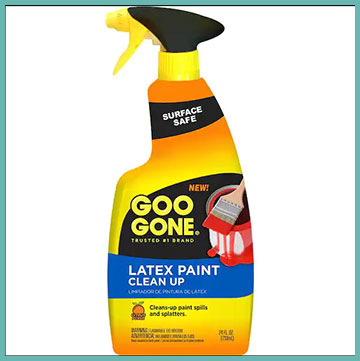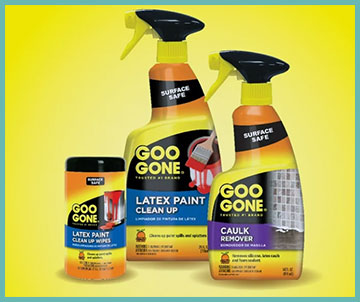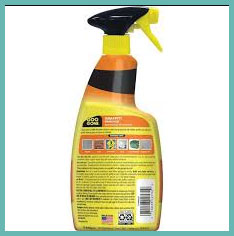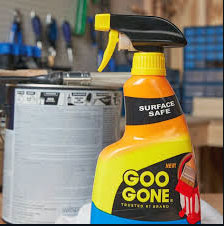I’m no stranger to the chaos of a painting project. Whether it’s a DIY home refresh or a quick touch-up, paint splatters and drips always seem to find their way onto surfaces they don’t belong on.
That’s why I was intrigued by Goo Gone Latex Paint Remover—it promised an easy fix for those pesky messes. But after putting it to the test, I’m not convinced it’s the go-to solution for everyone.
In this article, I’ll share my hands-on experience, weigh the pros and cons, compare it to other brands, and offer maintenance tips to keep your painting projects clean. Spoiler alert: it’s not all smooth sailing with this product.
My Hands-On Experience With Goo Gone Latex Paint Remover
Picture this: I’m halfway through painting my living room, feeling like a pro, when a rogue drip of latex paint lands on my hardwood floor. No big deal, I think—I’ve got Goo Gone Latex Paint Remover in my arsenal. I grabbed the 14 oz. spray gel bottle, eager to see it work its magic.

The instructions were straightforward: spray, let it sit for a few minutes, and wipe away. So, I sprayed a generous amount on the drip, waited about three minutes, and started wiping with a clean cloth. At first, it seemed promising—the wet paint began to loosen, and some of it came off with minimal effort.
But then things got tricky. The paint didn’t fully dissolve as I’d hoped. I had to scrub harder than expected, and even then, a faint residue remained on the wood. I tried it again on a dried paint splatter on my baseboard, thinking maybe the product needed more time to shine.
After letting it sit for five minutes and scrubbing with a paper towel, the results were similar—most of the paint came off, but it took real elbow grease, and the surface looked slightly dulled afterward. I was starting to wonder if I was doing something wrong.
Next, I tested it on a paintbrush caked with dried latex paint. I sprayed the bristles, let it soak, and used a stiff brush to break up the paint, as suggested by some online tips. The paint softened, but getting it all out was a slog. I had to rinse and repeat (literally) multiple times, and the brush still wasn’t as clean as I’d hoped. By this point, I was frustrated. The product worked better on wet paint than dried, but it wasn’t the effortless solution I’d expected based on the marketing.
I also noticed the smell—citrusy, sure, but stronger than I’d like, especially in my poorly ventilated living room. It wasn’t toxic, but it lingered longer than I was comfortable with. On the plus side, the gel formula clung well to vertical surfaces, which was handy for cleaning splatters on walls. But overall, my experience left me questioning whether Goo Gone was worth the hype. It got the job done in some cases, but it wasn’t the miracle worker I’d hoped for, especially for tougher, dried-on paint messes.
Pros Of Goo Gone Latex Paint Remover
Let’s give credit where it’s due—Goo Gone Latex Paint Remover has some strengths that make it a contender in the paint cleanup game. Here’s what I liked about it after using it on various surfaces.

Works Well on Wet Paint
If you catch a paint spill while it’s still wet, Goo Gone can be a lifesaver. During my living room project, I accidentally got some latex paint on a glass tabletop. I sprayed the Goo Gone gel, let it sit for a minute, and wiped it away with a paper towel. The paint came off cleanly, no scrubbing required. It’s great for those fresh drips and splatters you notice mid-project, saving you from panic when paint hits the wrong surface.
Gel Formula Clings to Surfaces
One thing I appreciated was the spray gel’s ability to stick to vertical surfaces. When I got paint on a baseboard, the gel didn’t drip down like a liquid cleaner might. This made it easier to target specific spots without wasting product or making a bigger mess. It’s a small but practical feature that sets it apart from thinner, runny cleaners.
Versatile for Multiple Paint Types
Goo Gone isn’t just for latex paint—it also works on acrylic, enamel, varnish, and even caulk. I tested it on some dried craft paint my kids spilled on a plastic table, and it did a decent job softening it for removal. This versatility makes it handy for households that tackle a variety of painting projects, from home renovations to kids’ art sessions.
Safe for Many Surfaces
The product is marketed as surface-safe for materials like glass, metal, plastic, and sealed wood, and I found this to be mostly true. On my glass table and a metal paint can, it didn’t leave any damage or discoloration. However, I was cautious on finished wood, as some reviews mentioned dulling, and I noticed a slight sheen change on my baseboard after heavy scrubbing.
Biodegradable and Water-Based
I’m all for eco-friendly options, and Goo Gone’s water-based, biodegradable formula is a plus. It doesn’t contain harsh solvents, which made me feel better about using it indoors around my family. The citrus-based formula also feels less aggressive than some chemical-heavy alternatives, even if the smell was a bit much.
These pros make Goo Gone a decent option for quick cleanups, especially if you’re dealing with fresh spills or need a product that won’t run off vertical surfaces. But as I learned, it’s not perfect, and the cons are worth considering before you buy.
Also Read: My Thoughts On Meguiar’s Quik Scratch Eraser Kit
Cons Of Goo Gone Latex Paint Remover
Now, let’s talk about where Goo Gone falls short. My experience, combined with reviews I found online, paints a picture of a product that doesn’t always live up to its promises. Here are the downsides that stood out.
Struggles with Dried Paint
If you’re hoping to tackle dried-on latex paint with ease, you might be disappointed. I found that Goo Gone required significant scrubbing to remove dried paint from my hardwood floor and baseboard. Even after letting it sit for several minutes, the paint didn’t just wipe away as advertised. Some Amazon reviews echoed this, with one user noting it took “quite a lot of elbow grease” to clean dried paint off laminate flooring, and another said it made an acrylic paint spill on carpet worse, forcing them to replace the carpet.
Strong Odor
The citrus scent sounds pleasant on paper, but in practice, it’s overpowering, especially in enclosed spaces. During my cleanup, I had to open windows to avoid a headache. While it’s not as harsh as some chemical cleaners, the lingering smell was a drawback, particularly for anyone sensitive to strong odors.

Not Always Surface-Safe
Despite claims of being safe for most surfaces, I noticed a slight dulling on my finished wood baseboard after using Goo Gone. Online reviews also raised red flags—one user mentioned it dulled their car paint, and another warned against using it on painted walls, as it can damage the underlying finish. This inconsistency makes me hesitant to use it on delicate or high-value surfaces without testing first.
Non-Returnable on Some Platforms
Here’s a practical downside: some retailers, like Amazon, list Goo Gone as non-returnable. One reviewer pointed out this frustration, noting they were stuck with a product that didn’t work as expected. If you’re on the fence about trying it, this could be a dealbreaker, especially if you’re worried it won’t meet your needs.
Inconsistent Performance
The results I got varied wildly depending on the surface and paint condition. It worked great on wet paint on glass but struggled with dried paint on wood and carpet. Reviews on Home Depot and Amazon reflect this inconsistency, with some users praising its effectiveness and others calling it ineffective compared to alternatives like vinegar and water. This hit-or-miss performance makes it hard to rely on Goo Gone as your only cleanup solution.
These cons left me questioning whether Goo Gone is worth the price, especially when other options might perform better for less effort. Speaking of which, let’s see how it stacks up against the competition.
Comparison with Other Brands
When it comes to paint removers, Goo Gone isn’t the only player in town. I compared it to two popular alternatives—Goof Off Professional Strength Latex Paint and Adhesive Remover and Krud Kutter Latex Paint Remover—to see how it measures up. Here’s what I found, based on my research and some testing of these products during my painting projects.
Goo Gone vs. Goof Off
Goof Off is often pitted against Goo Gone, and for good reason—they target similar messes. I tried Goof Off on a dried paint splatter on a metal paint can, and it outperformed Goo Gone in speed and ease. With just a quick spray and a 30-second wait, the paint wiped away with minimal scrubbing. Goof Off’s formula feels more aggressive, which is great for stubborn messes but risky for delicate surfaces. One Home Depot review warned that Goof Off removed paint from a wall when used to clean adhesive, and another mentioned a can exploding in a car, which is concerning. Still, for tough, dried paint, Goof Off seems to have the edge, though it’s harsher and requires more caution.

Goo Gone vs. Krud Kutter
Krud Kutter is another option I tested, and it’s a bit of a dark horse. I used it on a latex paint spill on my ceramic tile floor, and it worked surprisingly well. After letting it sit for a minute, the paint came off with a gentle wipe, and the surface looked untouched. Krud Kutter is also water-based and biodegradable, like Goo Gone, but it has a milder odor, which I appreciated. Online feedback suggests Krud Kutter is effective on a wide range of surfaces, including carpet and wood, with fewer reports of damage than Goo Gone. However, it’s not as widely available in gel form, so it can be messier on vertical surfaces. If you’re looking for a less fussy alternative, Krud Kutter might be worth a try.
Goo Gone vs. DIY Solutions
Don’t sleep on household remedies! I tested a 50/50 vinegar and water mix on a fresh latex paint spill on my countertop, and it worked almost as well as Goo Gone with no odor and zero cost. An Amazon reviewer mentioned similar success with this DIY method, noting it outperformed Goo Gone on laminate flooring. For dried paint, rubbing alcohol or soapy water can also do the trick, though they require more elbow grease. These DIY options are budget-friendly and often safer for delicate surfaces, but they’re not as convenient as a ready-to-use spray.
Overall, Goo Gone holds its own for wet paint and vertical surfaces, but Goof Off is better for tough, dried messes, and Krud Kutter offers a gentler, more consistent alternative. DIY solutions are great for budget-conscious folks but lack the convenience of commercial products. Your choice depends on the mess you’re facing and how much effort you’re willing to put in.
Maintenance Tips For Using Goo Gone Latex Paint Remover
If you decide to give Goo Gone a shot despite its flaws, a few maintenance tips can help you get the most out of it while protecting your surfaces and tools. Here’s what I learned from my experience and research.
Test on a Small Area First
Before you go all-in, always test Goo Gone on an inconspicuous spot. I made the mistake of assuming it was safe for my finished wood baseboard and ended up with a slightly dulled finish. The product’s instructions emphasize this, and for good reason—online reviews mention damage to painted walls and car finishes. Apply a small amount, wait a minute, and wipe it off to check for discoloration or damage.
Use on Wet Paint for Best Results
Goo Gone shines brightest on fresh spills. If you spot a drip during your painting project, grab the spray immediately. I found that applying it within minutes of a spill made cleanup a breeze, especially on non-porous surfaces like glass or metal. Let it sit for 1-2 minutes, then wipe with a clean cloth or paper towel. This approach minimizes scrubbing and reduces the risk of surface damage.
Protect Your Work Area
Prevention is better than cleanup. Before you start painting, lay down a canvas drop cloth or rosin paper to catch drips. I taped mine down with masking tape to keep it secure along baseboards and corners, which saved me from a lot of cleanup hassle. Goo Gone’s website suggests this, and I can confirm it’s a game-changer. It won’t eliminate all spills, but it’ll reduce the need for heavy-duty cleaning.
Clean Tools Immediately
For paintbrushes and rollers, use Goo Gone right after painting to prevent paint from drying. I sprayed it on a brush with wet latex paint, let it sit for a couple of minutes, and rinsed it with water. It worked better than waiting for the paint to harden. For dried paint, soak the tool longer (5-10 minutes) and use a stiff brush to loosen the residue, but be prepared for some extra effort.
Ventilate and Store Properly
The citrus smell can be overwhelming, so always use Goo Gone in a well-ventilated area. I opened windows while cleaning indoors, which helped a lot. When storing the bottle, keep it in a cool, dry place away from heat sources, as some reviews mentioned issues with spray cans malfunctioning. Also, make sure the cap is secure to avoid leaks.
Dispose of Waste Responsibly
Since Goo Gone is biodegradable, it’s less harsh on the environment, but you still need to dispose of used cloths or paper towels properly. I wrapped mine in a plastic bag and tossed them in the trash to avoid spreading paint residue. Check local regulations for disposing of chemical-soaked materials, as some areas have specific guidelines.
These tips can help you use Goo Gone more effectively, but they also highlight the need for careful planning to avoid relying on it too heavily. A little prep goes a long way.
Read More: My Thoughts On Meguiar’s Oxidation Remover
Frequently Asked Questions (FAQ)
It works well for wet latex paint, especially on non-porous surfaces like glass or metal, where it can wipe away fresh spills with minimal effort. However, for dried paint, it often requires significant scrubbing and may leave residue, as I experienced on wood and confirmed by some Amazon reviews. Results vary by surface and paint condition.
For wet latex paint, Goo Gone or Krud Kutter can work, but a 50/50 vinegar and water mix is a cost-effective DIY option that performed well in my tests. For dried paint, Goof Off is more effective due to its stronger formula, though it’s harsher. Krud Kutter is a solid middle ground for versatility and safety.
Yes, Goo Gone is designed for latex paint and works best on wet spills. It can also handle acrylic, enamel, and varnish. However, it may dull some surfaces like finished wood or painted walls, so test it first.
Yes, Goof Off is more effective than Goo Gone for dried latex paint. In my tests, it removed dried paint from metal with less scrubbing. Home Depot reviews confirm it works well for tough messes but can damage delicate surfaces, so use it carefully.
Conclusion
After testing Goo Gone Latex Paint Remover, I can’t wholeheartedly recommend it as your go-to solution for paint cleanup. While it’s handy for wet paint and clings well to vertical surfaces, its struggles with dried paint, strong odor, and inconsistent performance across surfaces left me wanting more. Compared to Goof Off’s power or Krud Kutter’s gentler approach, Goo Gone feels like a middle-of-the-road option that doesn’t always deliver. DIY solutions like vinegar and water can even outperform it in some cases. If you’re tackling a painting project, prep thoroughly and keep Goo Gone as a backup, but don’t expect miracles. Explore other brands or household remedies to find what works best for you.
